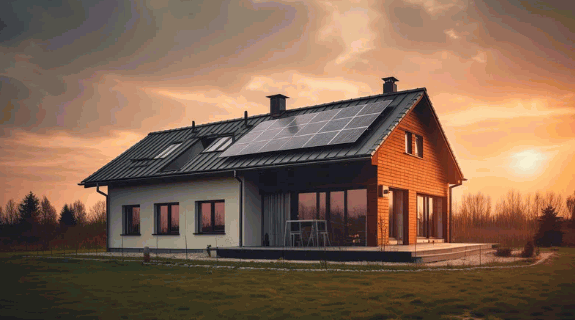Have you ever wondered why it’s important to clean your solar panels regularly?
In this article, we will explore the tools required to clean solar panels effectively, as well as step-by-step instructions on how to clean solar panels on the roof.
From safety precautions to gathering necessary tools and scrubbing with a soft brush, we’ve got you covered.
We will discuss how often solar panels should be cleaned, the benefits of regular cleaning, the risks of neglecting maintenance, and alternative methods such as using a solar panel cleaning robot or installing self-cleaning panels.
Stay tuned to learn everything you need to know about keeping your solar panels in top condition!
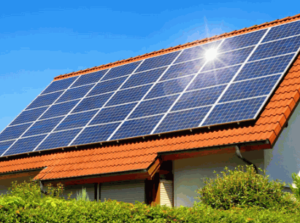
Why Is It Important To Clean Solar Panels?
Maintaining clean solar panels is crucial for ensuring optimal energy efficiency and maximizing solar output. Dirt and debris accumulation on solar panels can significantly reduce their efficiency over time, leading to decreased solar power generation and potentially higher maintenance costs.
Regularly cleaning solar panels is not just about enhancing energy efficiency; it also plays a vital role in prolonging the lifespan of your solar energy system. Ensuring that your panels are free from dirt and grime can help prevent potential damage and costly repairs in the long run. Following the manufacturer’s recommended cleaning instructions is essential to maintain the warranty and ensure the safety of both the panels and the person cleaning them.
Uncover more: How Much Does It Cost To Clean Solar Panels
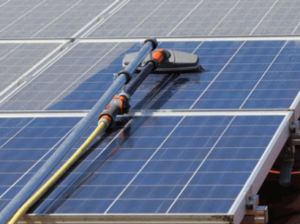
What Are The Tools Required To Clean Solar Panels?
To effectively clean solar panels, you will need basic tools like a soft brush, a gentle cleaning solution, and access to water. These tools are essential for safely removing dirt, grime, and debris from the surface of the panels without causing damage.
Consider using a squeegee for efficient water removal after cleaning, preventing water spots. A soft microfiber cloth can also be handy for the final touch and to ensure a streak-free finish on the panels. When choosing a cleaning solution, opt for environmentally-friendly options to maintain eco-friendliness. Remember that using inappropriate tools can lead to scratches or other damage, compromising the efficiency and lifespan of your solar panel system.
How To Clean Solar Panels On The Roof?
Cleaning solar panels on the roof involves a systematic approach to ensure effective dirt and debris removal while maintaining the integrity of the panel system. Start by following safety precautions and gathering the necessary tools before proceeding with the cleaning process.
Once you are equipped with the essential tools, such as a soft brush, a gentle cleaning solution, a hose or bucket, and a soft cloth, you can proceed to the next step. Begin by rinsing off any loose debris and dust from the surface of the panels using a gentle spray of water. Next, gently scrub the panels with a soft brush using a solution of water and mild soap to remove stubborn dirt and grime.
After scrubbing, rinse the panels thoroughly with clean water to ensure all soap residue is removed. Dry the panels with a soft cloth to prevent water spots and streaks, which can affect the efficiency of the panels. Remember, regular maintenance is key to ensuring the optimal performance of your solar panel system.

Safety Precautions
Before cleaning solar panels, it is crucial to prioritize safety precautions to prevent accidents or damage to the panels. Consider consulting a solar power professional for guidance on safe cleaning practices specific to your solar system.
Start by turning off the solar panel system to avoid any electric shocks during the cleaning process. Ensure that you do not come into direct contact with any electrical components to minimize the risk of injury. Make sure you have stable footing on the roof or use proper safety equipment if required.
Seeking expert advice for complex or high-risk cleaning tasks is always recommended to ensure the safety of both the panels and the individual performing the cleaning.
Gather Necessary Tools
Collect all the essential tools required for cleaning solar panels, including a soft brush, water source, and any specific cleaning solutions recommended for removing dirt and grime effectively.
Regarding cleaning solar panels, having a soft brush is crucial as it helps prevent scratches or damage to the delicate surface of the panels. A soft-bristled brush ensures that dirt and debris can be gently scrubbed away without causing any harm. A reliable water source is necessary to provide a steady stream of water for rinsing off the dirt and residues from the panels.
Selecting the right brush is paramount in the cleaning process. Opt for a brush specifically designed for solar panels, as it will be gentle yet effective in removing dirt without causing any scratching. Maintaining a consistent water supply is also important to ensure a thorough cleaning process and achieve optimal results in keeping your solar panels functioning at their best.
Rinse Off Loose Debris
Begin the cleaning process by rinsing off loose debris from the solar panels using water or a mild cleaning solution. This initial step helps to loosen dirt and prepare the surface for further cleaning.
Rinsing off loose debris before scrubbing the panels is crucial as it can prevent scratching or damage during the cleaning process. By getting rid of the larger particles first, you reduce the risk of these particles causing abrasions when you start scrubbing.
Using water pressure or gentle cleaning solutions can effectively remove accumulated dirt without causing harm to the panels. It’s important to strike a balance between a thorough clean and gentle treatment to ensure the longevity and efficiency of your solar panels.
Scrub With A Soft Brush
Use a soft brush to gently scrub the surface of the solar panels, focusing on areas with stubborn dirt or grime buildup. Avoid using abrasive tools that could scratch or damage the panels during cleaning.
When cleaning solar panels, it’s crucial to handle them with care to maintain their efficiency. By using a soft brush, you can effectively remove dirt without risking any potential damage. Remember to apply only gentle pressure and move in circular motions to ensure thorough cleaning and prevent any scratches. This method not only helps in preserving the integrity of the panels but also improves their performance over time. By incorporating these techniques into your cleaning routine, you can ensure that your solar panels continue to function optimally.

Rinse With Water
After scrubbing the panels, thoroughly rinse them with clean water to remove any remaining dirt debris or cleaning solution residue. Ensure that all traces of dirt are washed away to restore the panels’ efficiency.
Rinsing the solar panels thoroughly is a crucial step in the cleaning process. Using a gentle stream of clean water, start from the top of the panel and work your way down, ensuring every inch is covered.
The clean water helps to wash away not only the physical dirt but also any residual cleaning solution that might be left behind after scrubbing. This step is essential for maintaining the cleanliness and performance of the panels over time.
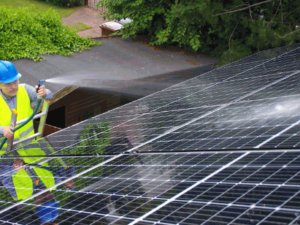
Dry With A Soft Cloth
Once the panels are rinsed, gently dry them with a soft cloth to prevent water spots and maintain a clean surface.
Effective drying of solar panels is crucial for not only maintaining their aesthetic appeal but also for optimizing their energy efficiency. By ensuring that the panels are completely free of moisture post-cleaning, you reduce the risk of water spots forming on the surface which can hinder sunlight absorption.
When using a soft cloth to dry the panels, be thorough in your approach, paying attention to every nook and cranny to avoid any residual water accumulation. A spotless surface translates to better performance and a longer lifespan of your solar panels.
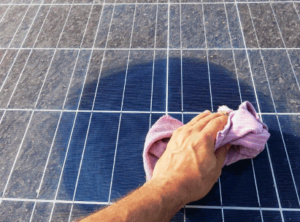
How Often Should Solar Panels Be Cleaned?
The frequency of cleaning solar panels depends on various factors such as the location, climate, and surrounding environment. In general, it is recommended to clean solar panels at least once or twice a year to maintain optimal energy production and efficiency.
Environmental conditions play a significant role in determining the cleaning frequency. For areas with high pollution levels or frequent dust storms, more frequent cleaning may be necessary to prevent buildup that can hinder sunlight absorption. Regions with heavy rainfall may naturally clean the panels to some extent.
The impact of dirt and debris on energy production cannot be overlooked. Even a thin layer of dust can reduce the efficiency of solar panels. Regular removal of such contaminants is crucial to ensure maximum energy output.
What Are The Benefits Of Regularly Cleaning Solar Panels?
Regularly cleaning solar panels offers numerous benefits, including improved energy efficiency, increased solar power output, and extended system lifespan. By keeping the panels clean, you can maximize their performance and reduce the need for costly maintenance.
When solar panels are covered with dust, dirt, or bird droppings, their ability to absorb sunlight diminishes, leading to reduced energy production. Clean panels, on the other hand, capture more sunlight, converting it into electricity at a higher efficiency rate. This not only boosts the overall output of your system but also results in substantial energy savings over time. Regular cleaning helps prevent potential damage caused by debris buildup, ensuring the longevity of your solar investment.
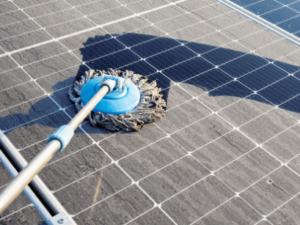
What Are The Risks Of Not Cleaning Solar Panels?
Neglecting to clean solar panels can pose significant risks to their performance and longevity. Accumulated dirt, grime, and debris can hinder solar power generation, reduce energy efficiency, and potentially lead to costly maintenance or repair issues.
Over time, the layer of dirt on solar panels acts as a barrier, blocking sunlight and reducing the panels’ ability to convert sunlight into electricity effectively. This decreased energy production not only impacts the system’s performance but also lowers the overall energy efficiency of the solar setup.
The presence of dirt can create hot spots on the panels, potentially damaging them and leading to system malfunctions over time. This could result in the need for expensive repairs or even the premature replacement of components.
By regularly cleaning the panels to maintain their efficiency, homeowners can prevent these issues and ensure that their solar energy system operates at its peak performance.
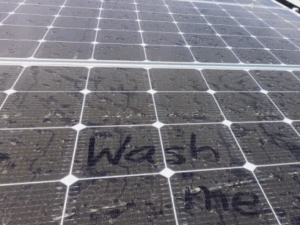
Are There Any Alternative Methods For Cleaning Solar Panels?
Along with manual cleaning methods, there are alternative approaches for cleaning solar panels, such as using solar panel cleaning robots or installing self-cleaning panels. These innovative solutions offer automated and efficient ways to keep solar panels free of dirt and debris.
Utilizing specialized solar panel cleaning robots can significantly reduce the time and effort required for maintenance, ensuring that the panels are kept in optimal condition without manual intervention. On the other hand, self-cleaning panel technologies use advanced coatings or mechanisms to prevent dust accumulation, enabling panels to clean themselves through natural processes like rainfall or wind. Both automation and self-maintenance play crucial roles in prolonging the lifespan and improving the overall performance of solar panel systems.
Using A Solar Panel Cleaning Robot
A solar panel cleaning robot is an automated solution designed to clean solar panels efficiently without manual intervention. These robots use advanced technology to remove dirt, grime, and debris from the panel surface, ensuring optimal performance and minimal maintenance requirements.
One of the key functionalities of these robots is their ability to navigate across the solar panel array autonomously, identifying areas that require cleaning.
By utilizing sensors and AI algorithms, they can detect dirty spots and apply the necessary cleaning mechanisms with precision.
The benefits of employing solar panel cleaning robots extend to increased energy production due to improved panel efficiency and reduced operational costs associated with manual cleaning processes.
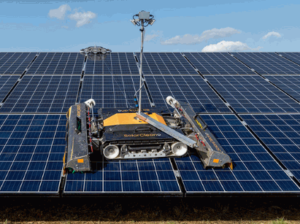
Installing Self-Cleaning Panels
Self-cleaning panels incorporate innovative technology that allows them to shed dirt and debris automatically, reducing the need for manual cleaning. These panels leverage natural elements such as rain or sunlight to maintain a clean surface and optimize energy production.
This mechanism not only saves time and effort but also leads to higher energy efficiency as dirt accumulation can significantly reduce solar panel performance. By staying clean, these panels can operate at maximum capacity, ensuring optimal energy generation. The self-cleaning feature enhances the longevity of the panels by reducing wear and tear caused by debris build-up. The ability of the panels to self-maintain results in a more efficient and durable solar power system.

